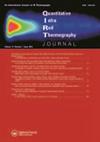Methodology to evaluate temperature changes in multiple sclerosis patients by calculating texture features from infrared thermography images
IF 4.9
3区 工程技术
Q1 INSTRUMENTS & INSTRUMENTATION
引用次数: 5
Abstract
ABSTRACT Multiple sclerosis (MS) is a progressive and degenerative disease that causes nerve conduction blocks due to demyelination in the central nervous system. Most MS patients experience a worsening of clinical signs and neurological symptoms when they are exposed to heat due to a thermoregulatory dysfunction. This paper proposes a novel methodology to understand temperature changes in MS patients by obtaining and evaluating texture features from infrared thermography (IRT) images. For that purpose, images of the legs of a MS patient and a healthy control subject with similar physical characteristics (while at rest and in a standing position) were recorded using a FLIR A655SC infrared camera. In the quantitative analysis of the resulting IRT images, three texture features (average, entropy, and uniformity) were computed, and the results were compared using statistical techniques. The statistical analysis showed that temperatures in the MS patient were not normally distributed, while those in the healthy control subject were normally distributed. In addition, significant differences in average, entropy, and uniformity were found between subjects. This methodology enables a quantitative evaluation of thermal distributions over different regions of the body and can be used in further studies into temperature changes in MS patients.通过计算红外热像图的纹理特征来评估多发性硬化症患者的温度变化的方法
摘要多发性硬化症(MS)是一种进行性和退行性疾病,由于中枢神经系统脱髓鞘而导致神经传导阻滞。大多数多发性硬化症患者在暴露于高温下时,由于体温调节功能障碍,临床症状和神经症状会恶化。本文提出了一种新的方法,通过从红外热像图(IRT)图像中获取和评估纹理特征来了解多发性硬化症患者的温度变化。为此,使用FLIR A655SC红外相机记录了一名MS患者和一名具有相似身体特征的健康对照受试者(在休息和站立时)的腿部图像。在对所得IRT图像的定量分析中,计算了三种纹理特征(平均值、熵和均匀性),并使用统计技术对结果进行了比较。统计分析显示,多发性硬化症患者的体温不呈正态分布,而健康对照受试者的体温呈正态分布。此外,受试者之间在平均值、熵和均匀性方面存在显著差异。这种方法能够定量评估身体不同区域的热分布,并可用于对MS患者温度变化的进一步研究。
本文章由计算机程序翻译,如有差异,请以英文原文为准。
求助全文
约1分钟内获得全文
求助全文
来源期刊

Quantitative Infrared Thermography Journal
Physics and Astronomy-Instrumentation
CiteScore
6.80
自引率
12.00%
发文量
17
审稿时长
>12 weeks
期刊介绍:
The Quantitative InfraRed Thermography Journal (QIRT) provides a forum for industry and academia to discuss the latest developments of instrumentation, theoretical and experimental practices, data reduction, and image processing related to infrared thermography.
 求助内容:
求助内容: 应助结果提醒方式:
应助结果提醒方式:


